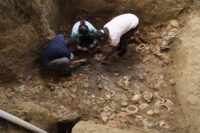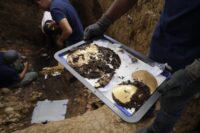 The tomb of a high-status man of the pre-Hispanic Coclé culture richly furnished with gold and ceramics has been unearthed at the El Caño Archaeological Site in Panama. The grave dates to 750-800 A.D. and is filled with ceramic artifacts buried as offerings. He was also laid to rest with a spectacular set of gold objects including five pectorals, two belts of gold beads, four bracelets, two anthropomorphic earrings (one of a male figure, the other female), an earring of a double crocodile, one necklace with small circular beads, five earrings made of sperm whale teeth covered in gold, a set of gold plates, two bells, bracelets, skirts made of dog teeth and a set of bone flutes.
The tomb of a high-status man of the pre-Hispanic Coclé culture richly furnished with gold and ceramics has been unearthed at the El Caño Archaeological Site in Panama. The grave dates to 750-800 A.D. and is filled with ceramic artifacts buried as offerings. He was also laid to rest with a spectacular set of gold objects including five pectorals, two belts of gold beads, four bracelets, two anthropomorphic earrings (one of a male figure, the other female), an earring of a double crocodile, one necklace with small circular beads, five earrings made of sperm whale teeth covered in gold, a set of gold plates, two bells, bracelets, skirts made of dog teeth and a set of bone flutes.
Dr. Julia Mayo, director of the El Caño Foundation and director of the archaeological project for 18 years, since the excavations began in 2008, explained that this collection could have belonged to a high-status adult male from the Rio chiefdom. Big.
Dr. Mayo stated that the tomb was built around the year 750 AD and is that of a great lord, but also of other people who died to accompany him to the “beyond.”
She explained that the excavation of the burial has not been completed, therefore, it cannot be determined at the moment how many people were buried with him, but what is known is that he was buried face down, a common way of burial in this society, on top pf the body of a woman.
 Located about 100 miles southwest of Panama City, the El Caño site was discovered in the 1970s when sugar cane tractors churned up Coclé artifacts. Subsequent archaeological explorations discovered funerary mounds encircled by massive standing stones. The enclosure within the circle of monoliths also contains a ceremonial area with wooden buildings. The burials belonged to a pre-Hispanic culture that occupied much of the modern-day province of Coclé from around 200 B.C. to 1550 A.D. The El Caño necropolis was built around 700 A.D. and abandoned around 1000 A.D.
Located about 100 miles southwest of Panama City, the El Caño site was discovered in the 1970s when sugar cane tractors churned up Coclé artifacts. Subsequent archaeological explorations discovered funerary mounds encircled by massive standing stones. The enclosure within the circle of monoliths also contains a ceremonial area with wooden buildings. The burials belonged to a pre-Hispanic culture that occupied much of the modern-day province of Coclé from around 200 B.C. to 1550 A.D. The El Caño necropolis was built around 700 A.D. and abandoned around 1000 A.D.
This discovery is important, among other things, because it presents a very special type of burial that “we know as multiple and simultaneous burials and we call them that because they consist of burials of a variable number of people (between 8 and 32 people) in a “The same tomb of high-status people who were buried along with others previously sacrificed to serve as companions,” explained specialist Mayo.